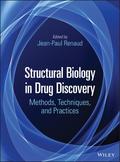Structural Biology in Drug Discovery
Methods, Techniques, and Practices

1. Edition March 2020
688 Pages, Hardcover
Wiley & Sons Ltd
Short Description
With the most comprehensive and up-to-date overview of structure-based drug discovery covering both experimental and computational approaches, Structural Biology in Drug Discovery: Methods, Techniques, and Practices describes principles, methods, applications, and emerging paradigms of structural biology as a tool for more efficient drug development. Coverage includes successful examples, academic and industry insights, novel concepts, and advances in a rapidly evolving field.
With the most comprehensive and up-to-date overview of structure-based drug discovery covering both experimental and computational approaches, Structural Biology in Drug Discovery: Methods, Techniques, and Practices describes principles, methods, applications, and emerging paradigms of structural biology as a tool for more efficient drug development. Coverage includes successful examples, academic and industry insights, novel concepts, and advances in a rapidly evolving field.
The combined chapters, by authors writing from the frontlines of structural biology and drug discovery, give readers a valuable reference and resource that:
* Presents the benefits, limitations, and potentiality of major techniques in the field such as X-ray crystallography, NMR, neutron crystallography, cryo-EM, mass spectrometry and other biophysical techniques, and computational structural biology
* Includes detailed chapters on druggability, allostery, complementary use of thermodynamic and kinetic information, and powerful approaches such as structural chemogenomics and fragment-based drug design
* Emphasizes the need for the in-depth biophysical characterization of protein targets as well as of therapeutic proteins, and for a thorough quality assessment of experimental structures
* Illustrates advances in the field of established therapeutic targets like kinases, serine proteinases, GPCRs, and epigenetic proteins, and of more challenging ones like protein-protein interactions and intrinsically disordered proteins
Preface
Chapter 01: The Evolving Role of Structural Biology in Drug Discovery
Chapter 02: A Structural View on Druggability: Experimental and Computational Approaches
Chapter 03: Structural Chemogenomics: Profiling Protein-Ligand Interactions in Polypharmacological Space
Chapter 04: Fragment-Based Ligand Discovery
Chapter 05: Combining Structural, Thermodynamic and Kinetic Information to Drive Hit-to-Lead Progression
Chapter 06: Allostery as Structure-Encoded Collective Dynamics: Significance in Drug Design
Chapter 07: Biophysical Assessment of Target Protein Quality in Structure-Based Drug discovery
Chapter 08: An Industrial Perspective on Protein-Ligand Complex Crystallization
Chapter 09: Membrane Protein Crystallization
Chapter 10: High-throughput Macromolecular Crystallography in Drug Discovery: Evolving in the Midst of Revolutions
Chapter 11: Assessment of Crystallographic Structure Quality and Protein - Ligand Complex Structure Validation
Chapter 12: Complementary Information from Neutron Crystallography Studies
Chapter 13: Determination of Protein Structure and Dynamics by NMR: State of the Art and Application to the Characterization of Biotherapeutics
Chapter 14: NMR Studies of Protein - Small Molecule Interactions for Drug Discovery
Chapter 15: Computational Structural Biology for Drug Discovery: Power and Limitations
Chapter 16: The Role of Structural Biology in Kinase Inhibitors Drug Discovery Success
Chapter 17: Serine Proteinases from the Blood Coagulation Cascade
Chapter 18: Epigenetic Proteins as Emerging Drug Targets
Chapter 19: Impact of Recently Determined Crystallographic Structures of GPCRs on Drug Discovery
Chapter 20: Targeting Protein-Protein Interactions Perspective
Chapter 21: Mass Spectrometry-Based Strategies for Therapeutic Antibodies Extensive Characterization and Optimization (OptimAbs)
Chapter 22: Integrating Evolution of Drug Resistance into Drug Discovery: Lessons from the Viral Proteases of HIV-1 and HCV
Chapter 23: A Comprehensive Review on Mycobacterium Tuberculosis Targets and Drug Development from a Structural Perspective
Chapter 24: Using Crystal Structures of Drug-Metabolizing Enzymes in Mechanism-Based Modeling for Drug Design
Chapter 25: Intrinsically Disordered Proteins (IDPs): Targets for the Future?
Chapter 26: Cryo-electron Microscopy as a Tool for Drug Discovery in the Context of Integrative Structural Biology
Chapter 27: Application of Hard-X-ray Free-electron Lasers for Static and Dynamic Processes in Structural Biology


